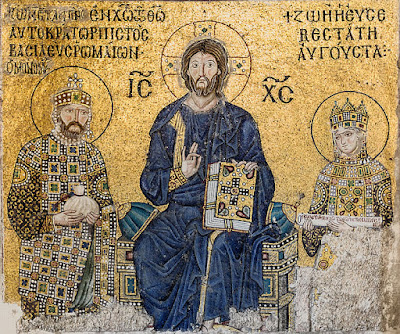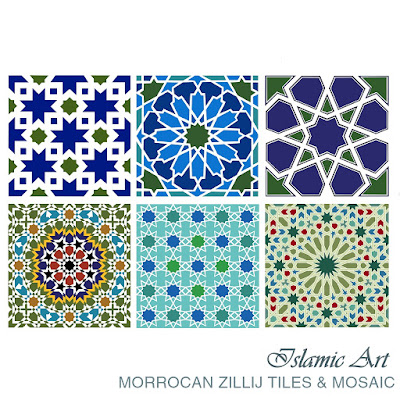The method of union of gold and glass for decorative purposes is believed to be discovered in Roman times. In the fourth century AD the use of gold and silver leaf infused glass mosaic tesserae was quite popular, mostly as fancy backgrounds of mosaic designs or to depict actual metallic & gold objects. Here are some of the best examples of incorporation of gold mosaic tiles in Christian and Byzantine art pieces and murals:
 |
'Empress Zoe Mosaic' at Hagia Sophia, Turkey
|
Very thin layers of gold and other precious metals were basically sandwiched between two slices of glass, one thicker than the other. Later, the pieces are cut to mosaic tiles of the desired size. The metal foil gives the tesserae reflective mirror-like effect. The art form got adopted by artists and craftsmen of the surrounding areas of Greece and Spain and then eventually to the entire Mediterranean region and rest of the world.
Overtime, its charm has persisted and gold mosaic is still recognized as a symbol for luxury, style and purity. The interesting fact is that even today, manufacturers of gold and platinum mosaic rely on centuries old techniques. The way has truly withstood the tests of time and is clearly evergreen.
How is Gold Mosaic Made?
It is made from real 24 carat gold. The gold has to be pure to withstand high temperatures and being beaten into a thin leaf to yield the best results. Here are the major steps involved in the process:
1. The gold is beaten till it takes the form of a very thin foil. The typical thickness is 0.15 micron. To get an idea of how thin it is consider this fact: one cubic centimeter or 20 grams of gold can make around six square meter sheet of foil for mosaics.
2. Next, pieces of very thing glass are made. This is achieved by creating an air bubble in thin glass and breaking that into smaller square glass fragments.
3. Now the gold foil is sandwiched between this thin slice of glass and another thicker glass layer. The thicker layer of glass is generally poured over in molten form. The heat bonds all the components together into a strong solid block.
4. Finally the sandwich is cut into smaller mosaic tiles. The sizes vary as per the requirement. Most commonly used sizes are 10, 15 and 20 mm squares. The thickness is around 5-8 mm.
MEC Gold & Platinum Collections
They say that not all glitters is gold. Good news, you don’t have to worry about that with MEC because authentic 24K Gold leaves are used in all our enchanting Gold Collection mosaic tesserae. We have a range of gold and platinum tiles based on texture and design variations that we utilize in different designs to add a touch of panache and elegance to our designs. Below you can see some of our best patterns that beautifully incorporate real gold mosaics:
Sources & References










